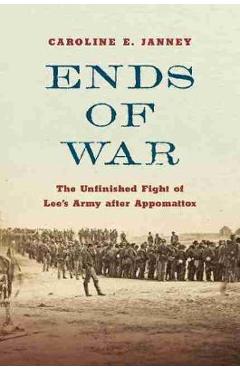Ends of War: The Unfinished Fight of Lee\'s Army After Appomattox - Caroline E. Janney

Detalii Ends of War: The Unfinished
libris.ro
122.76 Lei
136.4 Lei
History
Caroline E. Janney
Ends of War: The Unfinished - Disponibil la libris.ro
Pe YEO găsești Ends of War: The Unfinished de la Caroline E. Janney, în categoria History.
Indiferent de nevoile tale, Ends of War: The Unfinished Fight of Lee\'s Army After Appomattox - Caroline E. Janney din categoria History îți poate aduce un echilibru perfect între calitate și preț, cu avantaje practice și moderne.
Preț: 122.76 Lei
Caracteristicile produsului Ends of War: The Unfinished
- Brand: Caroline E. Janney
- Categoria: History
- Magazin: libris.ro
- Ultima actualizare: 05-06-2025 16:21:01
Comandă Ends of War: The Unfinished Online, Simplu și Rapid
Prin intermediul platformei YEO, poți comanda Ends of War: The Unfinished de la libris.ro rapid și în siguranță. Bucură-te de o experiență de cumpărături online optimizată și descoperă cele mai bune oferte actualizate constant.
Descriere magazin:
The Army of Northern Virginia\'s chaotic dispersal began even before Lee and Grant met at Appomattox Court House. As the Confederates had pushed west at a relentless pace for nearly a week, thousands of wounded and exhausted men fell out of the ranks. When word spread that Lee planned to surrender, most remaining troops stacked their arms and accepted paroles allowing them to return home, even as they lamented the loss of their country and cause. But others broke south and west, hoping to continue the fight. Fearing a guerrilla war, Grant extended the generous Appomattox terms to every rebel who would surrender himself. Provost marshals fanned out across Virginia and beyond, seeking nearly 18,000 of Lee\'s men who had yet to surrender. But the shock of Lincoln\'s assassination led Northern authorities to see threats of new rebellion in every rail depot and harbor where Confederates gathered for transport, even among those already paroled. While Federal troops struggled to keep order and sustain a fragile peace, their newly surrendered adversaries seethed with anger and confusion at the sight of Union troops occupying their towns and former slaves celebrating freedom. In this dramatic new history of the weeks and months after Appomattox, Caroline E. Janney reveals that Lee\'s surrender was less an ending than the start of an interregnum marked by military and political uncertainty, legal and logistical confusion, and continued outbursts of violence. Janney takes readers from the deliberations of government and military authorities to the ground-level experiences of common soldiers. Ultimately, what unfolds is the messy birth narrative of the Lost Cause, laying the groundwork for the defiant resilience of rebellion in the years that followed.

Produse asemănătoare
Produse marca Caroline E. Janney

Ends of War: The Unfinished Fight of Lee\'s Army After Appomattox - Caroline E. Janney
![]() libris.ro
libris.ro
Actualizat in 05/06/2025
167.4 Lei

Ends of War: The Unfinished Fight of Lee\'s Army After Appomattox - Caroline E. Janney
![]() libris.ro
libris.ro
Actualizat in 05/06/2025
122.76 Lei

The War That Made America: Essays Inspired by the Scholarship of Gary W. Gallagher - Caroline E. Janney
![]() libris.ro
libris.ro
Actualizat in 15/12/2024
268.87 Lei